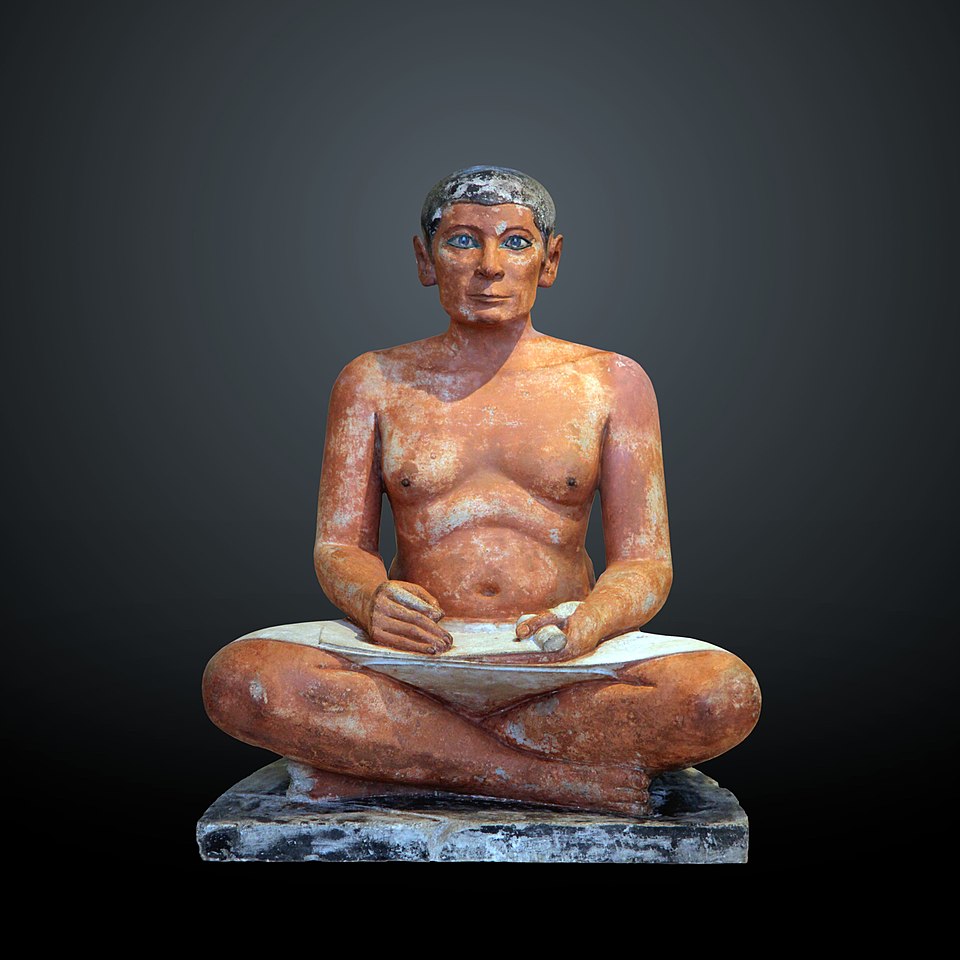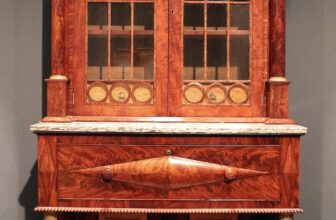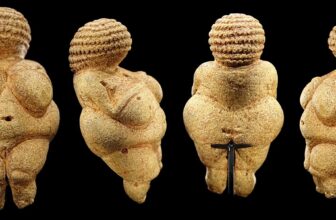
The Seated Scribe: A Timeless Gaze into Ancient Egypt
Nestled within the heart of the Louvre Museum in Paris, amidst a labyrinth of artistic treasures and relics of past civilizations, there sits a man unlike any other. He is not a king, nor a god, nor a warrior. He wears no crown, carries no weapon, and holds no staff of power. Yet for thousands of years, his presence has transfixed scholars, artists, and visitors alike. He is known simply as The Seated Scribe, and his still gaze continues to speak across millennia.
This sculpture, over 4,000 years old, is one of the most captivating and humanistic masterpieces of Ancient Egyptian art, and one of the Louvre’s most celebrated icons.
A Discovery from the Sands of Time
The Seated Scribe was discovered in 1850 at Saqqara, near the ancient city of Memphis, by French archaeologist Auguste Mariette. Saqqara served as the necropolis for Memphis, the capital of ancient Egypt during the Old Kingdom (c. 2700–2200 BCE). It is a place where many high-ranking officials were buried, often near the pyramids of kings they served.
Unlike royal statues carved from imperishable diorite and cast in godlike forms, this figure is humble in both form and context. The man is seated cross-legged, a papyrus scroll unfurled on his lap, and a now-missing writing implement poised in hand. His alert posture, soft midsection, and glass inlaid eyes give him a startling realism. When he was unearthed, those glass eyes still reflected the desert sun.
What Was the Purpose of the Seated Scribe?
To understand the purpose of the Seated Scribe, we must step into the social and spiritual landscape of ancient Egypt.
In ancient Egyptian belief, statues served more than decorative or commemorative roles. They were physical vessels for the ka, or life force, of the deceased. In tombs, these statues ensured that the individual’s soul could continue to exist and receive offerings in the afterlife. While pharaohs had monumental sculptures of themselves in grand temples and pyramids, high officials like scribes also commissioned statues to preserve their legacy and spiritual presence.
The scribe, though not of royal blood, held a critically important position in Egyptian society. He was educated, literate, and often served as a bureaucrat or administrator. In a civilization where literacy was rare and writing sacred, the scribe stood just below the elite, closer to the divine.
Thus, the Seated Scribe was not a mere portrait but a sacred object, a tool of spiritual continuity and commemoration. The purpose of the sculpture was likely twofold:
-
Spiritual: To serve as a home for the soul of the scribe in the afterlife.
-
Political/Social: To immortalize his role and contributions within the Egyptian bureaucracy.
Why Is the Seated Scribe in the Louvre So Famous?
Out of the thousands of sculptures that have survived from ancient Egypt, what makes this relatively modest figure in the Louvre stand out? Why does it continue to captivate modern audiences?
The fame of the Seated Scribe stems from a combination of artistic mastery, historical insight, and emotional resonance.
1. Realism and Expressiveness
Unlike the stylized and idealized forms common in Egyptian royal sculpture, where pharaohs are eternally youthful and godlike, the Seated Scribe is unapologetically human. His body is soft, showing age and perhaps a sedentary lifestyle. His face is alert, almost as if he’s been caught in the middle of writing something important. Most striking are his eyes: made of rock crystal, copper, and magnesite, they shimmer with uncanny realism.
This naturalism makes the statue feel alive. Many who stand before him in the Louvre report a feeling of being watched, not by stone, but by a sentient presence. This sense of direct human connection is rare in ancient art and partly explains the sculpture’s enduring fame.
2. Insight into Ancient Egyptian Society
The Seated Scribe offers a vivid window into the professional class of ancient Egypt. Most surviving sculptures from Egypt glorify kings and gods. In contrast, this figure represents an educated bureaucrat, a literate servant of the state whose pen was mightier than the sword.
Through this scribe, we learn about the machinery behind Egypt’s grand civilization. He was the one who recorded harvests, managed construction logistics, kept royal accounts, and chronicled history. Without scribes, Egypt’s monumental culture would not have functioned or endured.
3. A Mystery of Identity
Interestingly, the identity of the Seated Scribe remains unknown. While there were many statues in tombs inscribed with the names and titles of their subjects, this one lacks clear identification. Some scholars have speculated that it may represent a well-known scribe or priest from the late Fifth Dynasty (c. 2450–2325 BCE), but no consensus has been reached.
This anonymity adds to the sculpture’s mystique. He is simultaneously one man and every man, an archetype of intelligence, humility, and dedication.
What Is So Captivating About the Sculpture of the Seated Scribe?
There are many technical and emotional qualities that make the Seated Scribe one of the most compelling works of ancient art.
1. The Eyes That See
The most often mentioned feature is his gaze. Crafted with extreme precision, the eyes are made from inlaid crystal, held by copper rims, and accented with dark cosmetic lines. These eyes create the illusion of liveliness. As one moves around the statue, they seem to follow, reflecting ambient light and capturing attention.
This gaze feels not just lifelike, but intelligent, imbued with thought. It suggests the presence of a mind at work, capturing the spirit of a man whose occupation was defined by thought and observation.
2. Physical Form and Posture
The Seated Scribe is not the idealized athlete so common in classical Greek sculpture. He has a rounded belly, fleshy chest, and naturalistic wrinkles. His pose, seated cross-legged on the ground with his scroll open, is both relaxed and attentive. He is not in motion, but he is active, mentally, emotionally.
This careful balance between serenity and readiness reflects the scribe’s role: to listen, observe, and record.
3. A Moment Captured in Time
There is something cinematic about the sculpture. It feels as though we’ve entered a room, caught this man mid-task, and he’s just now looking up to meet our gaze. In that split second, an exchange occurs between ancient past and living present.
This momentary tension, this spark of inter-temporal recognition, is what transforms the sculpture from artifact to masterpiece.
Where Is the Seated Scribe in the Louvre?
The Seated Scribe is housed in the Sully Wing, Room 635, of the Louvre Museum in Paris. This wing is dedicated to the antiquities of Ancient Egypt, and the scribe is one of its stars. He is typically placed in a vitrine (glass case) at eye level, allowing visitors to come face to face with him.
The setting is intentional, subtle lighting enhances the glint of his crystal eyes, and the arrangement allows the viewer to walk around him, experiencing the sculpture from multiple angles. It’s a rare privilege to engage so intimately with a work so old, so rare, and so resonant.
The Seated Scribe in Modern Culture
The enduring power of the Seated Scribe has led to its appearance in numerous modern contexts.
-
Art Education: He is a staple in art history textbooks and museum studies programs.
-
Psychology and Philosophy: His lifelike presence has sparked discussions on perception, consciousness, and the uncanny valley.
-
Popular Culture: The statue has inspired artists, filmmakers, and writers fascinated by its humanity and timelessness.
In 2021, during the Louvre’s special exhibition “Pharaoh of the Two Lands”, the Seated Scribe was one of the main attractions, drawing tens of thousands of visitors. Even today, tourists often linger longer at this unassuming figure than at some of the museum’s grander works.
A Gaze That Endures
The Seated Scribe reminds us that history is not just kings and wars, but also people, individuals with thoughts, careers, emotions, and desires. He sits eternally alert, not as a god or conqueror, but as a witness. He bridges the distance between our world and his, inviting us to pause, observe, and perhaps, like him, reflect.
In a museum filled with grandeur, he captivates with humility.
In a world full of noise, he speaks in silence.
And in an age of fleeting attention, he teaches us to watch, to see, to understand, to remember.
That is the power of the Seated Scribe.



